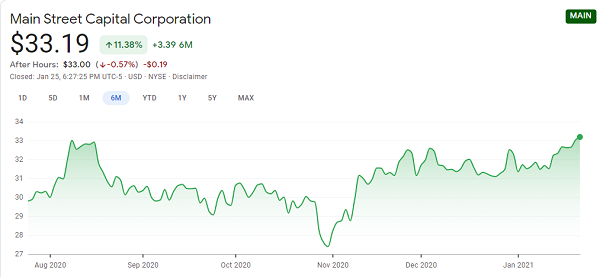As an entrepreneur, I look to invest in dividend growth companies because I like the passive income flow. Since my business income can fluctuate, having a stable base of income offers financial stability.
It’s like having a safety net of income.
I’ve recently discovered a new (to me) type of company known as a Business Development Company or BDC. A Business Development Company is a publicly-traded stock that is similar to a real estate investment trust (REIT) in that they pay no income taxes as long as they pay out 90% of their net income to investors. BDCs and REITs were special types of companies created by Congress.
Congress created this type of Regulated Investment Companies (RIC) with the 1980 Small Business Incentive Act. The goal was to facilitate investment in smaller companies that were not quite “investment grade.” Here’s a quick primer on the history of BDCs.
Outside of the favorable corporate tax treatment, BDCs behave a lot like private equity funds. They invest in a variety of things (both equity and debt) and oftentimes they focus on smaller companies that wouldn’t appeal to private equity firms. There are restrictions on what they can invest in – for example, at least 70% of assets must be in private US companies – and they are limited in leverage. Historically, that debt to equity ratio was 1 ($1 in debt to $1 in assets) but President Trump increased it to 2:1.
Like private equity firms, they sometimes will take an active role in advising those companies too – anything to improve their returns!
Table of Contents
What Do BDCs Invest In?
Business Development Companies tend to operate best in areas that are too large for individuals but too small for private equity firms – also known as the “middle market.” They also tend to “specialize” in certain areas so they aren’t lending to everyone and everything.
For example, Main Street Capital Corporation (MAIN) is a Houston-based company that offers capital funding to privately-held businesses. These are companies that make $10-$150 million a year with an EBITDA of $3-$20 million. They do so with a mix of equity (ownership) and debt (loans) and their average “initial investment size” is as low as $5 million.
To the average individual, this would be far too large. For a private equity firm, a firm with an EBITDA of $3 million would be too small. It would be appealing for a bank, though they would only ever do a debt instrument. They don’t want equity.
It’s on the lower end of what’s known as the middle market – which makes it appealing for BDCs like Main Street Capital Corporation.
Another example of a BDC that plays in this area is Ares Capital Corporation (ARCC), which happens to be the largest BDC by market capitalization ($7.32B), and they invest the majority of their assets in first-lien (44.6%) or second-lien loans (28%) to middle-market businesses. As of 9/30/2020, their portfolio has a fair value of around $14.4 billion.
Sometimes BDCs give you access to private equity but through the side door – take a look at Apollo Investment Corporation (AINV). Apollo Global Management is one of the largest and well-known firms in private equity but unless you have enough capital, you probably wouldn’t be able to invest in one of their funds. (you could buy shares of the company as they’re publicly traded but that’s different)
Finally, you have smaller BDCs that focus on certain markets – Hercules Technology Growth Capital (HTGC) is focused on venture lending (ie. technology, healthcare, SaaS finance, etc).
Internally vs. Externally Managed BDCs
Not all BDCs are created equal – there are internally and externally managed BDCs.
An internally managed BDC is one in which the company hires its own management team. It’s transparent in its compensation plan as it’ll outline expenses on the income statement.
An externally managed BDC is one in which all of those jobs are outsourced to a third party. They can be paid, usually, based on the fund’s assets and performance. In that regard, it’s similar to a hedge fund, which has structures like 2 and 20 (2% annually of assets under management and 20% of profits above a threshold).
Generally, internally managed BDCs have lower expense ratios and their interests are a bit closer in alignment. Externally managed BDCs get a part of their compensation as a percentage of AUM, so there’s a built-in incentive to increase AUM – something that doesn’t help existing investors.
Are Internally Managed BDCs Better?
Not necessarily. An internally managed BDC is not automatically better than any externally managed one – and we’ve mentioned one of the largest BDCs that happens to be externally managed – Ares Capital Corp.
Ares Capital Corporation is managed by Ares Management Corporation (ARES), which is a global specialty finance company founded in 1997 with $179 billion in AUM. This means that Ares Capital can get access to deals that other (smaller) internally managed BDCs probably wouldn’t.
It’s also important to recognize that there are different types of externally managed BDCs – some rely on a third party BDC management company. Others are simply a separate company closely affiliated with a much larger firm, as is the case with Ares Capital Corporation.
Does Cost Matter Though?
Of course!
A higher cost means a higher drag on the dividend yield and the stock price. If you have two BDCs both offering 9% yields and one charges you 1.5% while the other charges you just 1% – the 1.5% has to find that 0.5% of yield in its investments. Or borrow to pay the yield.
If they need 0.5%, they’ll likely enter in a few more higher risk loans which can have a compounding effect, especially when the economy sours. If there are defaults, it hits the fund’s net asset value which directly translates to the share price.
BDCs are Publicly Traded
This means the value of your shares will fluctuate.
Take a look at this 6 month chart on Main Street:

Remember that BDCs are investing in assets whose value will fluctuate but unlike other funds, their stock gets traded on the open market. A private equity fund doesn’t have a share price you can look at every day. BDCs do.
If you look at a lot of the charts from BDCs, many have take massive hits from the start of 2020 (pre-pandemic) until now because it’s unclear how many businesses will survive and many of them offer loans to those very companies under duress.
This is on top of how these are closed end funds so they have a NAV, which translates into the share price.
How to Analyze and Pick BDCs
If you’re convinced that BDCs are right for your portfolio, it’s time to do your homework. What numbers must you know about BDCs to have confidence you’re making a good investment?
This explainer by Simply Safe Dividends has an excellent section titled “How to Choose Quality BDCs” and he focuses on four numbers (that article offers ranges of what is considered conservative and aggressive for these figures, click through for those):
- Weighted average portfolio yield (on the BDCs loans and other assets) – lower is better because it means it’s less risky loans, also more likely to be weighted towards first lien debt.
- Net asset value per share – NAV/share is the intrinsic value of the business
- Non-accrual ratio – These are the number of loans that are in default
- Net Investment Income payout ratio – Clearly this will be over 90% but you want to see it under 100% since that means it’s sustainable.
Definitely read the Simply Safe Dividends article for the full details on these because it’s very good and offers solid direction.
How Are BDCs Dividends Taxed?
BDCs offer high yields – they’re required to pay out 90% of their income to their investors – but the disbursements they make are often not qualified dividends. They don’t get the favorable tax treatment of qualified dividends and you will be taxed at ordinary tax rates.
At the end of the year, they may also classify some of the year’s dividends as a “return of capital.” Return of capital isn’t a taxable event, it’s when the firm returns your own money, but it reduces your cost basis and could trigger a capital gain when you sell the shares later.
BDCs provide cash flow (good!) but it’s not at favorable tax rates (less good!). (also, using a dividend tracker can help you organize these)
How Do BDCs Maintain Dividend Yields?
Since Business Development Companies are investing in other businesses and debt instruments, it’s often a challenge to maintain a dividend, especially in a down market. If you’re invested in a BDC with a high yield, seeing it go down might push you to sell the holding.
Many BDCs, especially those with cyclical earnings, will rely on taking on debt to fund the dividend payments if they don’t want to cut the yield. Not ideal but what other option is there?
Another strategy is to keep a low regular dividend (keeping at around the 90% required) and rely on special “catch up” dividends in prosperous years (ie. they made too much, here’s more cash to get above the 90% required payout). This means the dividend yield looks slightly lower, when shown on stock screeners and the like, but the actual yield is higher.
When you analyze BDCs, you want to use the same rigors as you would with a dividend stock. You want a high percentage of dividend coverage, rising net asset values, a history of strong returns, etc.
Do You Need BDCs?
It depends – if you would like high yield cash flow and are comfortable with most of it coming from loans to businesses (a dicey proposition during a recession, let alone a pandemic), it might be a good idea.
As you compare different opportunities, remember that the payments made by BDCs are often not qualified dividends. You will be paying your ordinary income tax rates and not lower dividend rates, so calculating your tax rate will be important in comparing options.
Like any other investment, you must conduct your due diligence or you risk getting burned.



